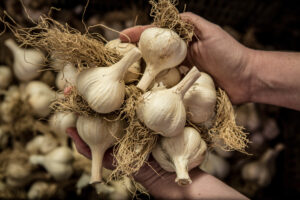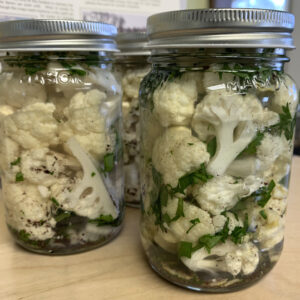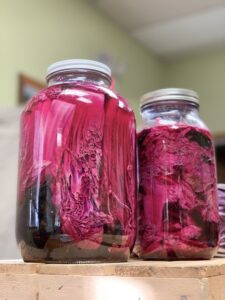
Now that you’ve experimented with the basic recipes we shared in part 1, here are some ways to get creative and wow folks at your next neighborhood potluck!
Herbs and Spices
For both the brined and dry-salted method, a good guide is to use 1 Tbsp of fresh herbs or spices or 1 tsp of dried herbs or spices. For example, if you want to use fresh garlic and fresh ginger use a 1/2 Tbsp of each, for a total of 1 Tbsp fresh spices in the jar. Same goes for powdered spices or dried herbs: mix up as many spices as you like adding up to a total of 1 tsp/pint jar. Salt will stay the same at 1 1/2 tsp/pint jar.
Mix it Up!
For the brined method, consider adding whole fresh herbs to your jar, like flowering dill or whole peeled cloves of garlic. These flavors will infuse in the brine even if they aren’t chopped up. Plus, they look amazing! A mixed pickle with different vegetables, herbs, and spices is so easy and creates beautiful colors and fresh flavors.
For the dry-salted method, you can blend a wide variety of herbs and spices and vegetables. Try mixing chopped wild greens like dandelion or nettles (wear gloves!) into your krauts. Or experiment with making your own kimchi-style ferment with any number of ingredients like Napa cabbage, green cabbage, carrots, radishes, chives, scallions, garlic, ginger, or chile peppers.
Taste it!
Don’t wait until your ferments get going to taste them – you should taste your recipe when you are mixing all your ingredients together before packing it into the jar. Do you like the flavor? Could it use a little more of something? Add it! The flavors will meld and mellow during fermentation, but if you like how it tastes before it’s fermented then there’s a good chance you’ll like it when it’s finished too! Don’t worry if it tastes saltier than you’d like because the salty flavor will mellow too.
Extra Tips for Experimentation
Most veggies lend themselves quite well to fermenting, however there are a few we’d recommend taking extra care with. Onions and mushrooms don’t naturally have enough lactic acid bacteria to ferment well on their own. They are delicious when fermented with other veggies, like cucumbers with onions, or shredded cabbage with some thinly sliced mushrooms. You might also encounter veggies that seem like they would be delicious fermented but end up smelling so funky it’ll clear the room (asparagus!). Try mixing these in with other veggies for a more delicious result. Consider also that sometimes the smell of ferments is very different from the taste. If you are discouraged, say, by the sulfury smell from fermented onions, don’t give up on the ferment. Open it out on the porch and take a forkful – despite the smell, the taste could be delightful! Discovering what works and what you like to eat is part of the fun of home fermentation!
Download this worksheet to help organize your recipe!
Pint-Size Kraut Recipe Ideas
1) Red & Green: 8 oz. red cabbage, 8 oz. green cabbage, 1 1/2 tsp salt
2) Golden Kraut: 10 oz. green cabbage, 3 oz. carrot, 3 oz. beet, 1 1/2 tsp salt
3) Ginger Pink: 12 oz. green cabbage, 4 oz. beet, 1 Tbsp ginger, 1 1/2 tsp salt
4) What’s that Smell?: 12 oz. green cabbage, 2 oz. onion, 2 oz. carrot, 1/2 tsp black pepper, 1 1/2 tsp salt
5) Simple Kraut: 16 oz. green cabbage, 1 tsp caraway, 1 1/2 tsp salt
Fermentation Resources and Inspiration
Create Your Own Small Batch Kraut Recipe (2023, Katie Korby)
The Art of Fermentation by Sandor Katz (2012, Chelsea Green)
The Pickled Pantry by Andrea Chesman (2012, Storey)
Fiery Ferments by Kirsten & Christopher Shockey (2017, Storey)
Fermented Vegetables by Kirsten & Christopher Shockey (2014, Storey)
Cultured Foods for Your Kitchen by Leda Scheintaub (2014, Rizzoli)
Recipes from the Herbalist’s Kitchen by Brittany Wood Nickerson (2017, Storey)
How to Ferment Vegetables from CityHomesteads.com
Clay fermenting crocks:






